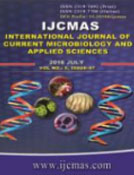


 National Academy of Agricultural Sciences (NAAS)
National Academy of Agricultural Sciences (NAAS)

|
PRINT ISSN : 2319-7692
Online ISSN : 2319-7706 Issues : 12 per year Publisher : Excellent Publishers Email : editorijcmas@gmail.com / submit@ijcmas.com Editor-in-chief: Dr.M.Prakash Index Copernicus ICV 2018: 95.39 NAAS RATING 2020: 5.38 |
Fungal infections of hospital origin have been gaining importance in recent years due to their progressive increase with high rate of morbidity and mortality. Our study reports the results of environmental surveillance of fungi in specific areas of two tertiary care hospitals of Dr. S.N. Medical College, Jodhpur-Rajasthan. Study was conducted from January2015 to 2016. Samples from the air of two local tertiary care hospitals were collected on a monthly basis. The air sampling was done by passive sedimentation method on petriplates containing Sabouraud’s dextrose agar medium supplemented with gentamycin for one hour in respective areas then sealed and sent to the Department of Microbiology for processing by standard microbiological procedures. This study find out different contamination levels at different areas of hospital with100 fungal isolates: Candida albicans (n =22), C.parapsilosis (n=15), Candida tropicalis (n=5), Rhodotorula (n =2), Trichosporon (n = 1), Aspergillus spp.(n =45), Mucor spp.(n=5) & Penicillium spp.(n=5). In general most of these isolates were found to be resistant to Flucanazole, Itraconazole & Clotrimazole while Voriconazole is still most sensitive. Opportunistic mycoses have been increased in recent years in our study as well as international health facilities. In our findings, C.albicans, Candida parapsilosis, non-Candida yeast species & many moulds were common which might be coming from human clinical material as well as from environmental samples. Results of our study were very similar to Raimunda Sâmia N. Brilhante et al study. Our study emphasize on strict hospital environmental monitoring for fungi to prevent possible fungal nosocomial infections because of our negligence about air contaminants fungi may causes severe opportunistic fungaemia with very high morbidity & mortality.
 |
 |
 |
 |
 |